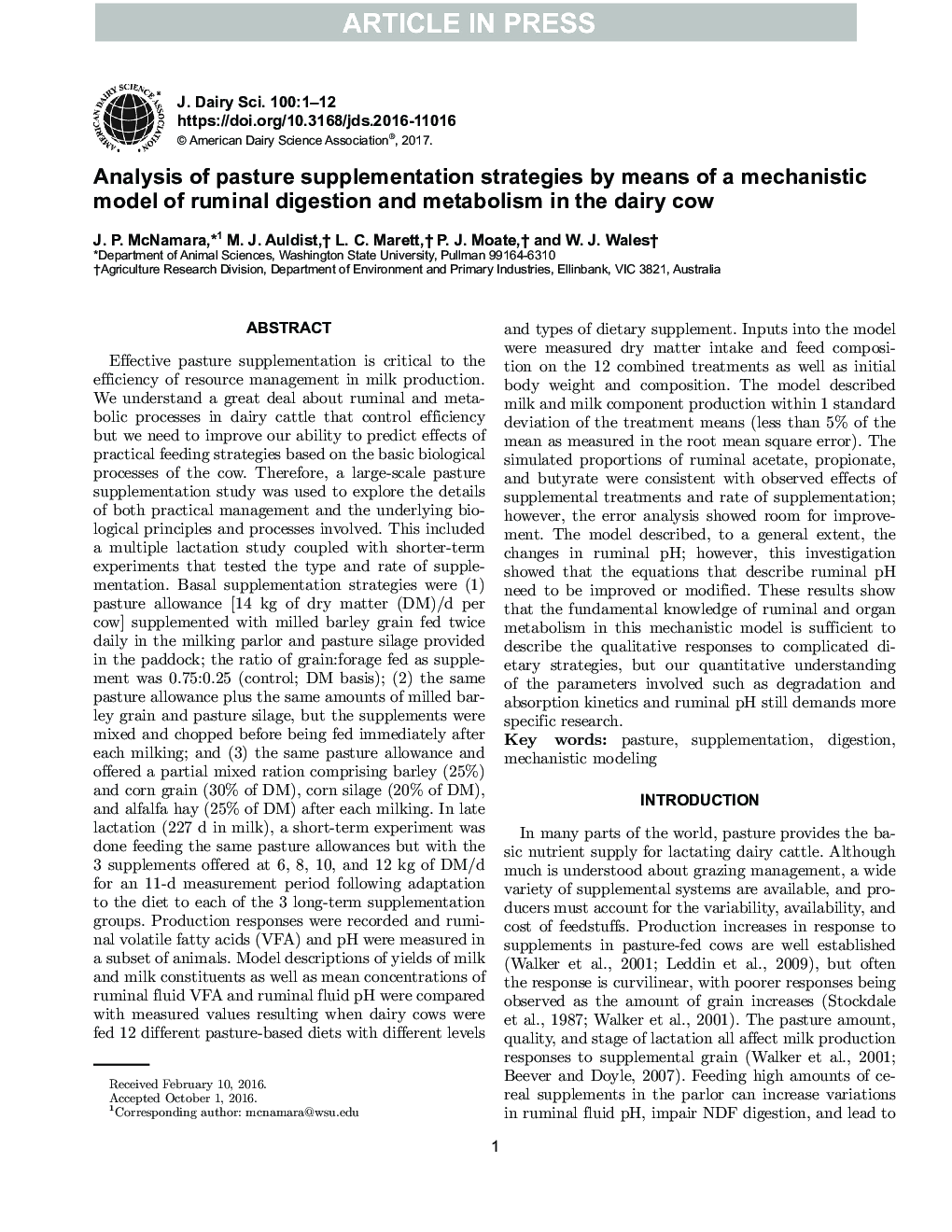| کد مقاله | کد نشریه | سال انتشار | مقاله انگلیسی | نسخه تمام متن |
|---|---|---|---|---|
| 5542419 | 1402518 | 2017 | 12 صفحه PDF | دانلود رایگان |
عنوان انگلیسی مقاله ISI
Analysis of pasture supplementation strategies by means of a mechanistic model of ruminal digestion and metabolism in the dairy cow
ترجمه فارسی عنوان
تجزیه و تحلیل استراتژی های مکمل گیاهان دارویی با استفاده از یک مدل مکانیکی هضم شام و متابولیسم در گاو شیری
دانلود مقاله + سفارش ترجمه
دانلود مقاله ISI انگلیسی
رایگان برای ایرانیان
کلمات کلیدی
مرتع، مکمل هضم، مدل سازی مکانیکی،
موضوعات مرتبط
علوم زیستی و بیوفناوری
علوم کشاورزی و بیولوژیک
علوم دامی و جانورشناسی
چکیده انگلیسی
Effective pasture supplementation is critical to the efficiency of resource management in milk production. We understand a great deal about ruminal and metabolic processes in dairy cattle that control efficiency but we need to improve our ability to predict effects of practical feeding strategies based on the basic biological processes of the cow. Therefore, a large-scale pasture supplementation study was used to explore the details of both practical management and the underlying biological principles and processes involved. This included a multiple lactation study coupled with shorter-term experiments that tested the type and rate of supplementation. Basal supplementation strategies were (1) pasture allowance [14 kg of dry matter (DM)/d per cow] supplemented with milled barley grain fed twice daily in the milking parlor and pasture silage provided in the paddock; the ratio of grain:forage fed as supplement was 0.75:0.25 (control; DM basis); (2) the same pasture allowance plus the same amounts of milled barley grain and pasture silage, but the supplements were mixed and chopped before being fed immediately after each milking; and (3) the same pasture allowance and offered a partial mixed ration comprising barley (25%) and corn grain (30% of DM), corn silage (20% of DM), and alfalfa hay (25% of DM) after each milking. In late lactation (227 d in milk), a short-term experiment was done feeding the same pasture allowances but with the 3 supplements offered at 6, 8, 10, and 12 kg of DM/d for an 11-d measurement period following adaptation to the diet to each of the 3 long-term supplementation groups. Production responses were recorded and ruminal volatile fatty acids (VFA) and pH were measured in a subset of animals. Model descriptions of yields of milk and milk constituents as well as mean concentrations of ruminal fluid VFA and ruminal fluid pH were compared with measured values resulting when dairy cows were fed 12 different pasture-based diets with different levels and types of dietary supplement. Inputs into the model were measured dry matter intake and feed composition on the 12 combined treatments as well as initial body weight and composition. The model described milk and milk component production within 1 standard deviation of the treatment means (less than 5% of the mean as measured in the root mean square error). The simulated proportions of ruminal acetate, propionate, and butyrate were consistent with observed effects of supplemental treatments and rate of supplementation; however, the error analysis showed room for improvement. The model described, to a general extent, the changes in ruminal pH; however, this investigation showed that the equations that describe ruminal pH need to be improved or modified. These results show that the fundamental knowledge of ruminal and organ metabolism in this mechanistic model is sufficient to describe the qualitative responses to complicated dietary strategies, but our quantitative understanding of the parameters involved such as degradation and absorption kinetics and ruminal pH still demands more specific research.
ناشر
Database: Elsevier - ScienceDirect (ساینس دایرکت)
Journal: Journal of Dairy Science - Volume 100, Issue 2, February 2017, Pages 1095-1106
Journal: Journal of Dairy Science - Volume 100, Issue 2, February 2017, Pages 1095-1106
نویسندگان
J.P. McNamara, M.J. Auldist, L.C. Marett, P.J. Moate, W.J. Wales,
